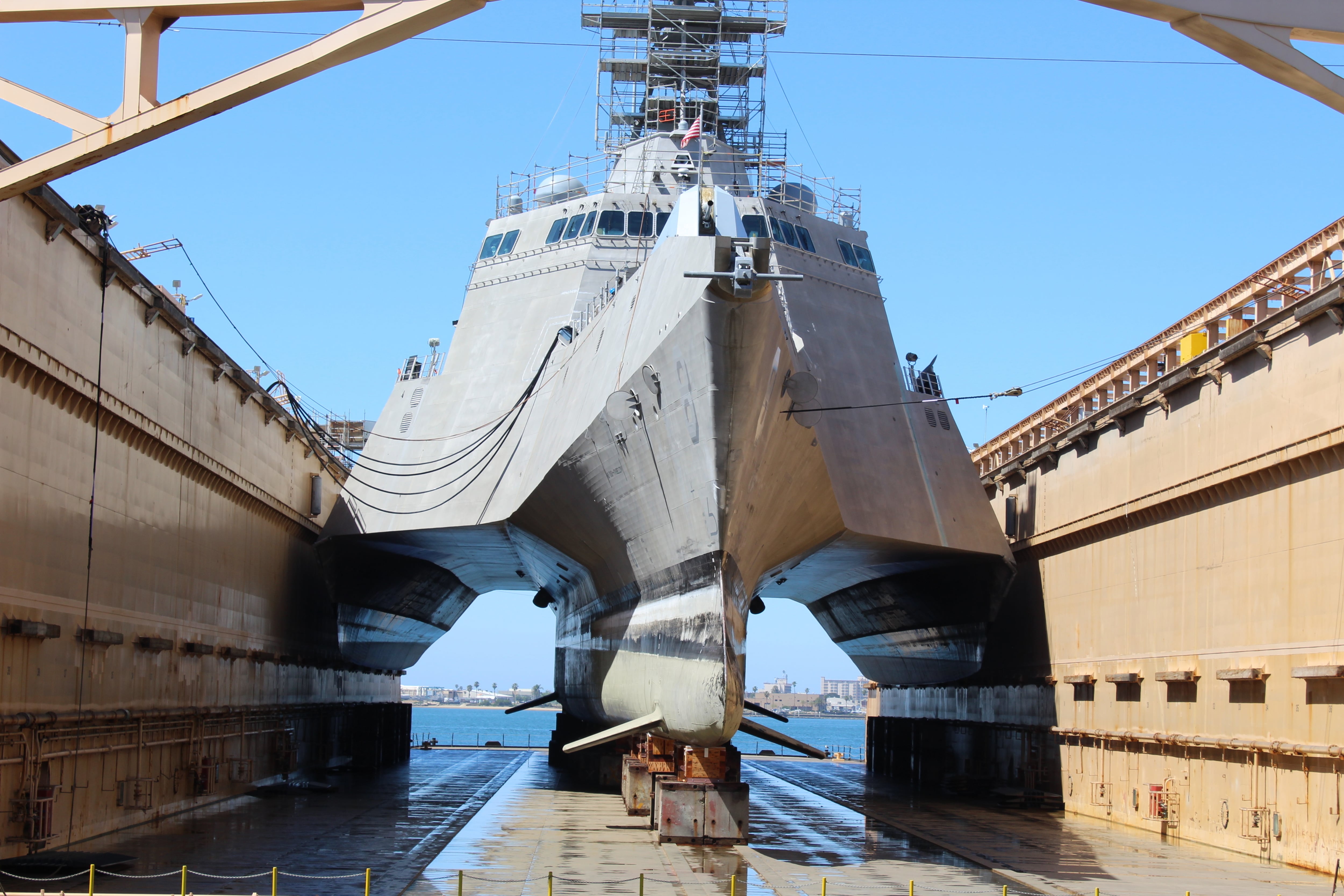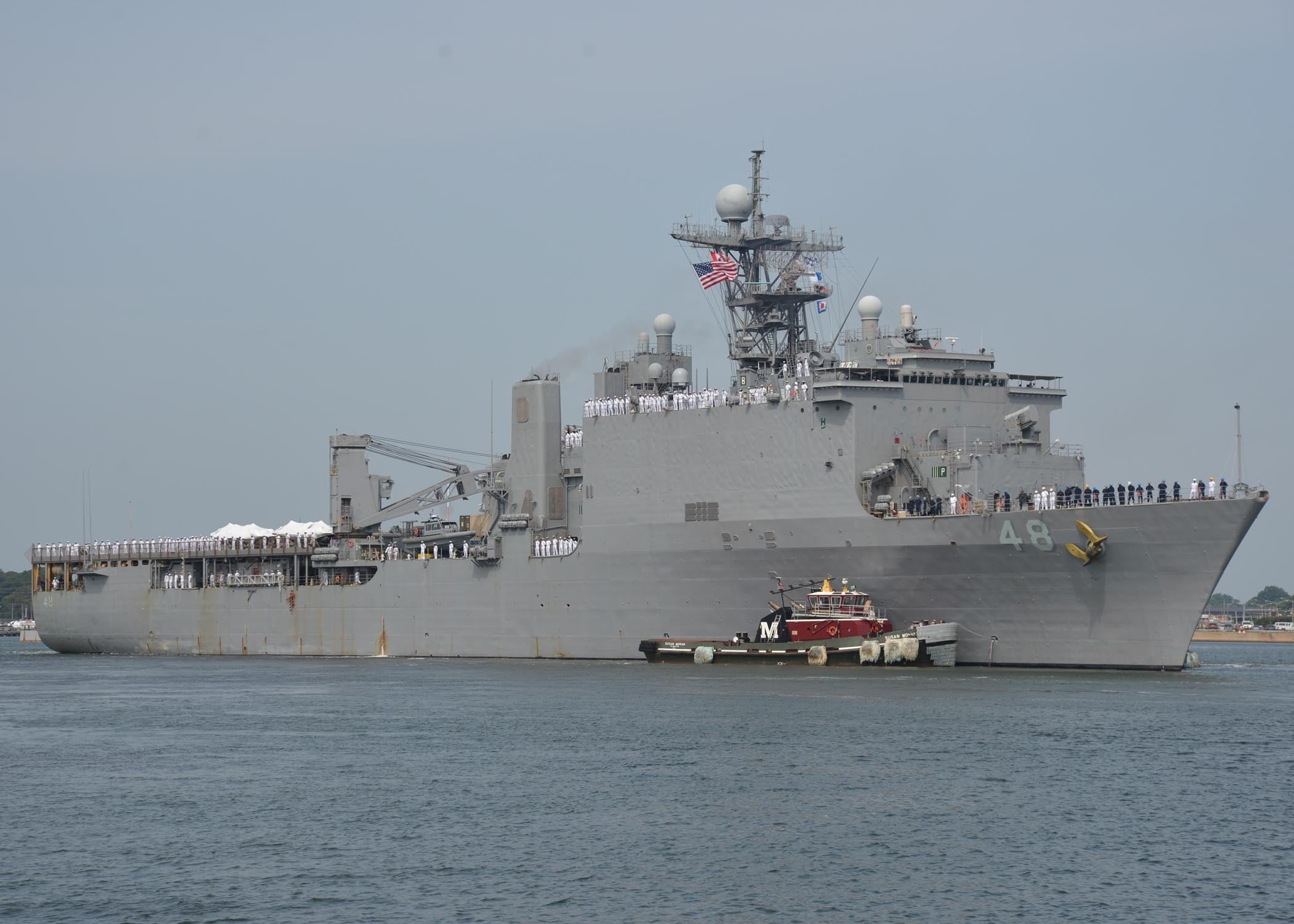WASHINGTON — The U.S. Navy intends to decommission 11 ships in fiscal 2024, including eight ahead of their planned end of service life — fewer than the 24 it requested to decommission in its FY23 submission, but still likely to reignite debate on Capitol Hill.
Those set for early retirement as part of a divestment strategy include three Whidbey Island-class amphibious dock landing ships the Navy tried to retire last year; three Ticonderoga-class cruisers, one of which the Navy tried to retire last year; and two Independence-variant littoral combat ships that would be just eight and nine years old at decommissioning.
The Navy would lose a cumulative 54 years of service life from these ships under this plan.
The service also plans to decommission two additional cruisers and one attack submarine that have reached the end of their planned life.
Erik Raven, undersecretary of the Navy, told Defense News in a March 10 media roundtable the service “did a ship-by-ship review to understand the material state of each of the ships” set for early retirement.
In considering further investment in repair, modernization and operations for these individual ships, “as judged hull by hull, the return on investment is not there,” he added. “We have sailors and Marines who are serving on these ships; we think that getting them matched up with the right platforms is the way to go.”
Rear Adm. John Gumbleton, the deputy assistant secretary of the Navy for budget and director of fiscal management, said in a March 13 budget briefing that “for the cruisers and [amphibs], the decision to request this divestment was based on material condition, life remaining, cost and then time to upgrade, and of course the resultant warfighting value. These six vessels did not pass” that return-on-investment analysis.
Congress last year rejected the Navy’s plan, with lawmakers voting to save four amphibious ships, five LCSs and a cruiser from early retirement.
Here’s a look at the plan the Navy has put forward this year.
Two littoral combat ships
The Navy is proposing the early retirement of LCSs Jackson and Montgomery, which were commissioned in 2015 and 2016 respectively. These ships were meant to serve for 25 years.
This proposal comes, simply, because the Navy bought more ships than it now says it needs.

The Navy determined in a 2021 review its ideal fleet would have 15 Independence-variant ships on the West Coast and 6 Freedom-variant ships on the East Coast, all capable of operating with the surface warfare mission package and the Indy-variants also capable of using a mine countermeasures mission package.
As a first step, the Navy asked in its FY23 budget to decommission all Freedom-variant LCSs, which have a flawed combining gear and would cost an undisclosed amount of money to fix with a new combining gear system. The Navy determined, based on its need for just six ships to conduct surface warfare in the Atlantic fleet, it would decommission these existing ships and await delivery of the final six ships in the class, which would be built with the proper combining gear design.
Congress rejected this idea, instead saving five of the hulls.
This year, though, there’s nothing materially wrong with the two LCSs set for decommissioning. The Navy needs 15 Independence-variant hulls and will have 19 by the time the remaining ones deliver from Austal USA. The two oldest in the fleet are up for decommissioning in 2024, even though that would leave the Navy with 12 until the next couple deliver to the fleet.
Naval Surface Forces spokesman Cmdr. Arlo Abrahamson told Defense News decommissioning Jackson and Montgomery allows the Navy to spend on higher-priority ships, as well as “reallocate manpower and critical skillsets to bolster our remaining LCS crews and other fleet assets” to increase near-term readiness.
“There are no near-term risks associated with these proposed decommissionings. Adequate inventory of hulls exist to support the operational demand,” he added.
Gumbleton said during the roundtable the decommissioning plan is not tied to any particular outcome for the hulls, but that the Navy would look into selling them to an ally or partner.
Three amphibious ships, again
The Navy will try again this year to convince Congress of the need to decommission three Whidbey Island-class LSDs: the Germantown, Gunston Hall and Tortuga.
The Navy requested to decommission these three, plus the Ashland, in its FY23 plan, but Congress voted to save all four. The service is once again looking to decommission them early: Germantown would be 38 years into a 40-year planned life, Gunston Hall would be 35 and Tortuga would be 34.
A draft FY24 memo, obtained by Defense News as the Navy and Marine Corps were finalizing their budget plan to send to the Defense Department for further work, showed the Navy wanted to decommission four other notably younger LSDs. It appears that, during negotiations in the late summer and early fall, the Navy abandoned the effort to retire the four younger ships and decided to restart negotiations with Congress over Germantown, Gunston Hall and Tortuga.

Raven said during the press briefing these particular ships “are challenged in terms of readiness.”
Still, the Marine Corps insists its forces need these ships.
Commandant of the Marine Corps Gen. David Berger said last week the overall readiness of the entire amphibious fleet was just 32%, quite a bit lower than other parts of the Navy ship fleet. But he added that the Marine Corps needs the Navy to maintain an inventory of 31 total amphibs or risk the Marines not being able to respond to a crisis or conflict.
Cruiser Vicksburg, also again
The Navy and Congress have also debated cruisers in recent years. The FY24 proposal asks to decommission Cowpens, Shiloh and Vicksburg, each of which would be 32 or 33 years into their 35-year planned life.
Last year, the Navy asked to decommission four cruisers that had reached the end of their planned service life, and Vicksburg early, but Congress voted to save Vicksburg.
The Navy struggled to get some of the cruisers through a lengthy, multi-phase overhaul and life extension, as and the service has tried to ditch some of these ships rather than continue to pour money into the hulls.
The service has previously argued the ships aren’t a sound investment, and in fact a Navy budget book notes that accelerating the Cowpens’ decommissioning from the planned 2026 timeline to 2024 would save $130 million amid the ship’s “increased maintenance availability costs and poor return on investment in terms of operational employment and capability.”
Chief of Naval Operations Adm. Mike Gilday last spring also offered another argument: the ships aren’t safe. He referred to several emergent repairs during cruiser deployments, including ones involving water leaking into the main engine room or berthing areas below the water line. The ships have also faced ongoing cracks in fuel tanks.
The Office of the Secretary of Defense offered up an additional pitch in its FY24 budget briefing: the cruisers are less necessary “as the mission transitions to Flight III” Arleigh Burke-class destroyers, the first of which is going through trials now ahead of its delivery to the Navy later this year.
Megan Eckstein is the naval warfare reporter at Defense News. She has covered military news since 2009, with a focus on U.S. Navy and Marine Corps operations, acquisition programs and budgets. She has reported from four geographic fleets and is happiest when she’s filing stories from a ship. Megan is a University of Maryland alumna.





